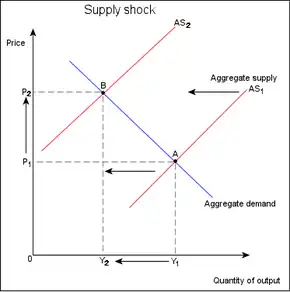Supply shock
A supply shock is an event that suddenly increases or decreases the supply of a commodity or service, or of commodities and services in general. This sudden change affects the equilibrium price of the good or service or the economy's general price level.
| Part of a series on |
| Macroeconomics |
|---|
.JPG.webp) |
In the short run, an economy-wide negative supply shock will shift the aggregate supply curve leftward, decreasing the output and increasing the price level.[1] For example, the imposition of an embargo on trade in oil would cause an adverse supply shock, since oil is a key factor of production for a wide variety of goods. A supply shock can cause stagflation due to a combination of rising prices and falling output.
In the short run, an economy-wide positive supply shock will shift the aggregate supply curve rightward, increasing output and decreasing the price level.[1] A positive supply shock could be an advance in technology (a technology shock) which makes production more efficient, thus increasing output.
Technical analysis

The slope of a demand curve determines how much the price level and output respond to the shock, with more inelastic demand (and hence a steeper demand curve) causing there to be a larger effect on the price level and a smaller effect on quantity.
See also
References
- Robert Hall, Marc Lieberman (2012), Economics: Principles and Applications, Cengage Learning, p. 849, ISBN 978-1-111-82234-7
Bibliography
- Czech, Brian, Supply Shock: Economic Growth at the Crossroads and the Steady State Solution, (Gabriola Island, Canada, 2013)